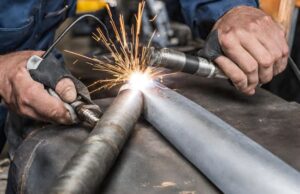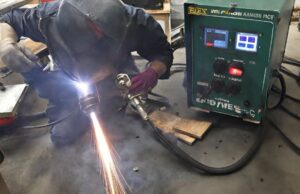Table of Contents
Welcome to the ultimate guide on how to fix TIG welding problems. If you’re an aspiring welder or a seasoned pro, you know that TIG welding can sometimes be a challenging task. But worry not, because we’re here to help you troubleshoot those pesky issues and get your TIG welds looking flawless.
Overview of TIG Welding
TIG (Tungsten Inert Gas) welding is a popular welding method known for its accuracy and ability to weld various metals. However, even experienced welders encounter issues during TIG welding that affect the final weld quality.
5 Common TIG Welding Problems
TIG welding, while renowned for its precision, can encounter various issues that hinder the welding process. These problems, if left unaddressed, can compromise the quality and integrity of the welds. Understanding these common TIG welding problems is essential for welders to troubleshoot effectively and produce high-quality welds consistently.
1. Inconsistent Arc
Maintaining a stable and consistent arc is fundamental in TIG welding. However, welders often face challenges with arc stability, leading to inconsistencies during the welding process.
Factors such as incorrect settings, improper electrode handling, or contaminated materials can disrupt the arc, resulting in unstable and flawed welds. An inconsistent arc affects the overall quality of the weld and demands immediate attention to rectify the issue.
2. Porosity and Contamination
Porosity, characterized by small holes or voids in the weld, is a prevalent issue in TIG welding. It occurs primarily due to contamination from surface impurities, such as oil, moisture, or debris, contaminating the welding area.
When the weld pool solidifies, these contaminants create voids, weakening the weld’s strength and structural integrity. Contamination can severely impact the weld’s quality and durability, making it crucial to identify and eliminate sources of contamination.
3. Tungsten Electrode Issues
The tungsten electrode plays a pivotal role in TIG welding, contributing to arc stability and precision. Issues related to the electrode, such as incorrect size, improper shape, or contamination, can significantly affect the welding process.
A damaged or contaminated electrode leads to erratic arc behavior, resulting in flawed welds. Regular inspection, proper handling, and maintenance of tungsten electrodes are imperative to ensure consistent and high-quality welds.
4. Incomplete Penetration
Incomplete penetration occurs when the weld fails to penetrate the base material adequately. This issue arises from incorrect settings, inadequate welding techniques, or improper electrode placement. Insufficient penetration compromises the weld’s strength and structural integrity, posing a risk of weld failure.
Welders must address this problem by adjusting parameters and employing proper techniques to ensure complete penetration into the base material.
5. Spatter and Welding Defects
Spatter, the expulsion of molten metal particles during welding, is a common issue that affects TIG welds. Improper gas shielding, incorrect welding parameters, or inadequate surface preparation contribute to spatter formation.
Additionally, other welding defects, such as undercuts, weld cracks, or distortions, can occur due to various factors, impacting the weld’s quality. Reducing spatter and eliminating welding defects require careful adjustment of parameters and meticulous surface preparation.
Understanding these common TIG welding problems is pivotal for welders to troubleshoot effectively and implement corrective measures, ensuring consistent and high-quality welds. Addressing these issues promptly and employing preventive strategies is key to achieving impeccable TIG welds consistently.
Identifying TIG Welding Problems
Identifying TIG welding problems accurately is a critical skill for welders to ensure the quality and integrity of their welds. Detecting issues early on allows for timely intervention, minimizing the impact on the final weld. Here’s a detailed overview of how welders can effectively recognize common TIG welding problems:
- Visual Inspection
Visual inspection serves as the primary method to identify potential welding issues. Welders examine the weld bead, looking for irregularities such as spatter, porosity, cracks, or inadequate fusion. Observing the weld’s appearance, size, and shape provides crucial insights into potential problems.
- Weld Testing
Performing various tests on the weld helps assess its quality and detect any underlying issues. Non-destructive testing methods like dye penetrant testing, ultrasonic testing, or X-ray examination can reveal hidden defects or discontinuities within the weld.
- Understanding Problem Characteristics
Each welding issue exhibits specific characteristics that aid in identification. For instance, porosity appears as small voids or bubbles within the weld, while inconsistent arc results in irregular and unstable weld beads. Recognizing these unique characteristics assists in pinpointing the root cause of the problem.
- Consultation and Experience
Seeking advice from experienced welders or welding professionals can provide valuable insights into identifying and resolving welding issues. Drawing from their expertise and experience can help in recognizing subtle signs that indicate potential problems.
- Record Keeping and Analysis
Maintaining records of welding parameters, materials used, and previous welding experiences enables welders to analyze patterns and trends in welding issues. This data-driven approach helps in identifying recurring problems and devising effective preventive measures.
- Advanced Monitoring Systems
Utilizing advanced monitoring systems and sensors during welding processes can aid in real-time detection of anomalies. These systems track parameters like voltage, current, and gas flow, alerting welders to deviations from the set parameters.
- Training and Continuous Learning
Ongoing training and staying updated with the latest welding techniques and technologies equip welders with the knowledge to identify and address evolving welding challenges effectively.
Identifying TIG welding problems relies on a combination of visual inspection, testing, experience, and continuous learning. Welders equipped with these skills and approaches can promptly detect issues, leading to timely interventions and the production of high-quality welds.
Troubleshooting Techniques for TIG Welding Problems
Troubleshooting is a crucial skill for welders when addressing TIG welding problems. Implementing effective techniques to resolve issues ensures consistent weld quality. Here are detailed techniques to troubleshoot common TIG welding problems:
1. Adjusting Amperage and Voltage
Fine-tuning amperage and voltage settings is fundamental to stabilize the welding arc. Welders can experiment with slight adjustments to these parameters to achieve a stable and consistent arc, addressing issues related to arc instability.
2. Cleaning and Preparing Surfaces
Thoroughly cleaning and preparing surfaces before welding is vital to prevent contamination-induced issues like porosity. Using suitable cleaning agents and tools to remove dirt, oil, rust, or any contaminants ensures a clean welding surface.
3. Correcting Tungsten Electrode Issues
Addressing problems with the tungsten electrode involves ensuring it’s the correct size, shape, and free from contamination. Proper sharpening and careful handling of the electrode prevent arc instability and defects in the weld.
4. Optimizing Gas Flow and Shielding
Maintaining proper gas flow and selecting the appropriate shielding gas are critical for TIG welding. Adjusting gas flow rates and ensuring adequate coverage over the weld pool prevents issues like spatter and contamination.
5. Techniques for Reducing Spatter
Fine-tuning welding parameters, such as wire speed and voltage, can minimize spatter during TIG welding. Additionally, using anti-spatter solutions or employing techniques like backstepping helps reduce spatter formation.
Implementing these troubleshooting techniques empowers welders to address common TIG welding issues effectively. By adjusting parameters, preparing surfaces meticulously, maintaining electrode integrity, optimizing gas flow, and employing anti-spatter techniques, welders can enhance weld quality and consistency.
Preventive Measures for TIG Welding Issues
Preventing TIG welding issues is as crucial as troubleshooting them. Implementing proactive measures significantly reduces the occurrence of common problems, ensuring consistently high-quality welds. Here are detailed preventive measures for TIG welding issues:
1. Regular Equipment Maintenance
Routine inspection and maintenance of welding equipment, including the welding machine, torch, and gas regulators, prevent unexpected breakdowns and ensure optimal performance during welding.
2. Proper Storage of Materials
Storing welding materials, especially consumables like electrodes and filler rods, in controlled environments away from moisture, dust, and contaminants preserves their integrity, minimizing the risk of welding issues.
3. Correct Technique Training
Providing comprehensive training to welders on correct TIG welding techniques, including proper electrode handling, surface preparation, and gas shielding, significantly reduces the occurrence of common issues.
4. Welding Parameter Control
Establishing and adhering to standardized welding parameters based on material types, thicknesses, and joint configurations minimizes the risk of inconsistency and ensures reliable weld quality.
5. Material Inspection and Preparation
Thoroughly inspecting base materials for cleanliness, quality, and surface conditions before welding and meticulously preparing them by removing any contaminants or impurities mitigates the risk of issues like porosity.
6. Quality Control Procedures
Implementing stringent quality control checks at various stages of welding, including visual inspection, non-destructive testing, and weld validation, ensures that welds meet specified standards and reduces the likelihood of defects.
7. Continuous Improvement and Training
Encouraging continuous learning and improvement among welding personnel through training programs and knowledge-sharing sessions fosters a culture of excellence and keeps welders updated on the latest techniques and technologies.
8. Welding Environment Management
Maintaining a clean, well-ventilated welding environment free from distractions and ensuring proper ventilation systems reduces the chances of contamination and promotes optimal welding conditions.
By proactively implementing these preventive measures, welding operations can significantly reduce the occurrence of common TIG welding issues. This proactive approach not only enhances weld quality but also minimizes downtime, ensuring efficient and consistent welding outcomes.
Conclusion
Addressing TIG welding problems involves a combination of proactive measures and effective troubleshooting techniques. By understanding the common issues and implementing corrective and preventive measures, welders can consistently produce high-quality welds.
FAQs: about How to Fix TIG Welding Problems
How can I prevent porosity in TIG welding?
Properly cleaning and preparing surfaces, along with ensuring adequate gas shielding, can help prevent porosity.
What causes an inconsistent arc in TIG welding?
Incorrect settings, contaminated materials, or improper electrode maintenance can lead to an inconsistent arc.
Why is tungsten electrode maintenance crucial in TIG welding?
The tungsten electrode directly impacts arc stability and weld quality; maintaining it ensures optimal performance.
Can adjusting welding parameters reduce spatter?
Yes, fine-tuning parameters like voltage and wire speed can minimize spatter during TIG welding.
How important is ongoing training for welders in preventing welding issues?
Ongoing training helps welders stay updated on techniques and best practices, reducing the occurrence of welding problems.



11 thoughts on “How to Fix 5 Common TIG Welding Problems”